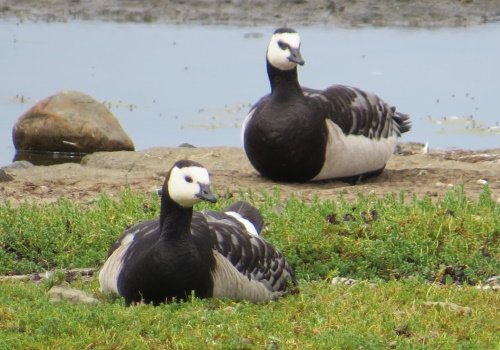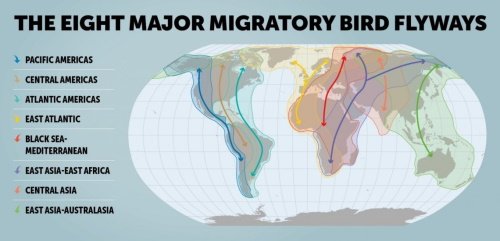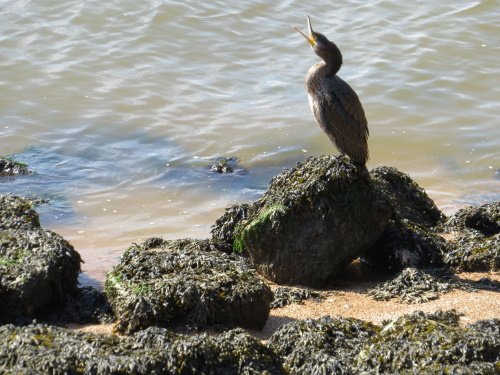May 9 was
world migratory bird day
. I have never really liked birds, I even was afraid of them when I was a child. I still don’t like them fluttering around my head. But last year’s
visit to a bird ringing station near Lake Baikal
I found fascinating – those little birds that cover such large distances and are smart enough to fly around the lake. That, and the fact that I can relate to the OCD that often comes with the serious birder, inspired me to polish up our existing connection
Bird Migrations
.

Barnacle Geese in Southern Öland: long-distance migrants which breed in the Russian Arctic.
The connection’s definition is: “WHS that are
key stopover sites
for birds on one of the
major flyways
.” So far it has 48 entries, let’s make some sense of it:
What’s a Flyway?
Wiki
says: “A flyway is a flight path used by large numbers of birds while migrating between their breeding grounds and their overwintering quarters. Flyways generally span continents and often pass over oceans”. It’s good to keep in mind that it is a human construct, a label to be able to manage bird populations better. It's not an exact route.
Do all birds migrate?
No, most woodpeckers and owls for example don’t. But the majority of the bird species do in some way or another. Not all use the major flyways though: some only move around to feeding areas a short distance away. Approximately 1800 of the world’s 10000 bird species are long-distance migrants (
source
).
How many Flyways are there actually?
The answer to this varies with the source you consult. At the highest abstraction level, there are 3: Americas Flyway, African-Eurasian Flyway and East Asian-Australasian Flyway. These 3 are usually divided into 8 to 10 more precise flyways.
BirdLife International
,
the
global organization for the conservation of birds, distinguishes the following:

Which WHS derive (part of) their OUV from bird migrations?
No less than 28 of the 48 connected WHS attribute at least a part of their OUV to bird migrations. A further 6 mention birds in general, but they may be more focused on endemic species or those that ‘only’ are involved in regional migrations.
Tikal
and Iran’s
Hyrcanian Forests
are examples of the latter.
Notable omissions among the 28 are cultural landscapes such as
Southern Öland
and the
Saloum Delta
, which have been inscribed for their human interactions but also are important bird migration wise.
Are all flyways covered by WHS?
Yes, all 8 are. The Eastern Atlantic flyway, where birds migrate from their breeding grounds in Europe to tropical Africa, apparently is the busiest route. It also has the most bird migration WHS, with important stopovers like
Banc d’Arguin
,
Donana
and the
Wadden Sea
.
The Central Asian Flyway is the shortest, cut short by the Tibetan plateau. The Black Sea-Mediterranean (called Western Palaearctic in some sources) also isn’t well known, but does include our perennial non-favourite WHS
Lake Srebarna
.
Which WHS receives the most migratory birds?
According to the comparative analysis in the nomination dossier, the Dutch and German parts of the
Wadden Sea
yearly receive 10-12 million birds each year. It is seen as “the most important area for migratory birds, in the context of the East Atlantic Flyway”. So that would make it the busiest stopover on the most used route.

Cormorants stopping over in the Wadden Sea.
With a coverage of 48 out of the 1121 WHS (= 4%), bird migration seems to be a subject well-covered. It is also likely that more sites could be considered for this connection: all
Ramsar sites
for example (we have connected 94 of them) are known for their waterfowl habitats, though these might focus on resident birds or those on shorter migration routes (such as
Aldabra
and
Socotra
).
The
IUCN Gaps document
from 2004, outlining underrepresented themes and areas on the World Heritage List, does not mention bird migrations and instead suggests to focus on
Endemic Bird Areas.
This is habitat-based bird conservation, the opposite of migratory bird conservation. However, we have
57 WHS with endemic bird species
also already identified. So it seems that we have exhausted the potential for bird related WHS by now.
Do you know of any great birding sites that have been overlooked?



